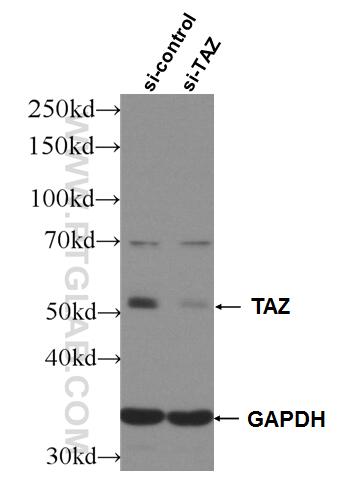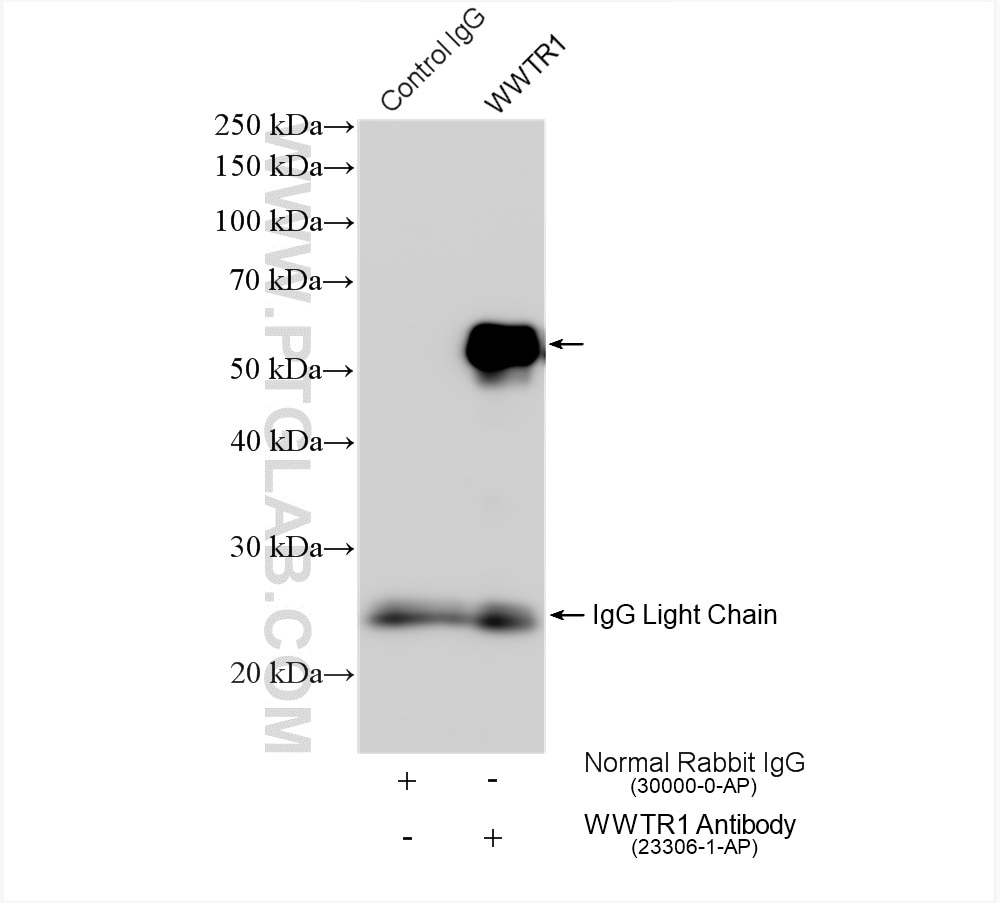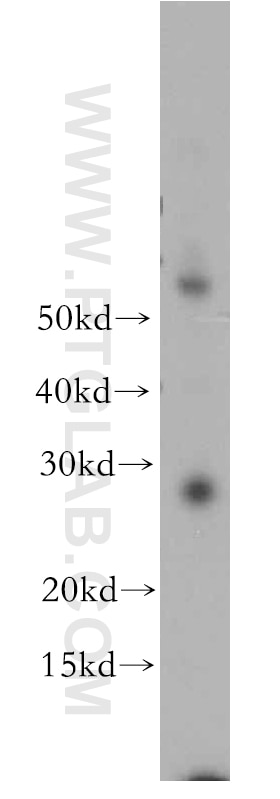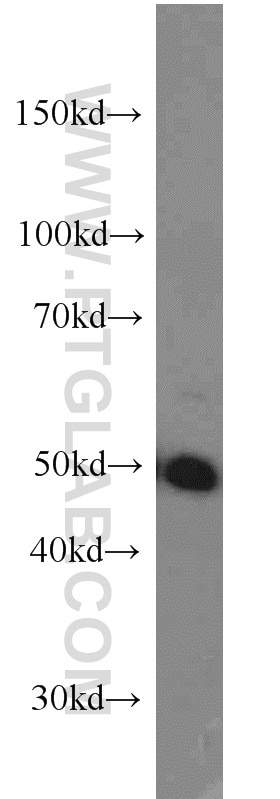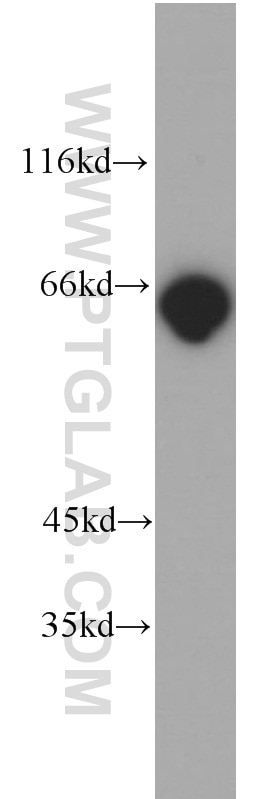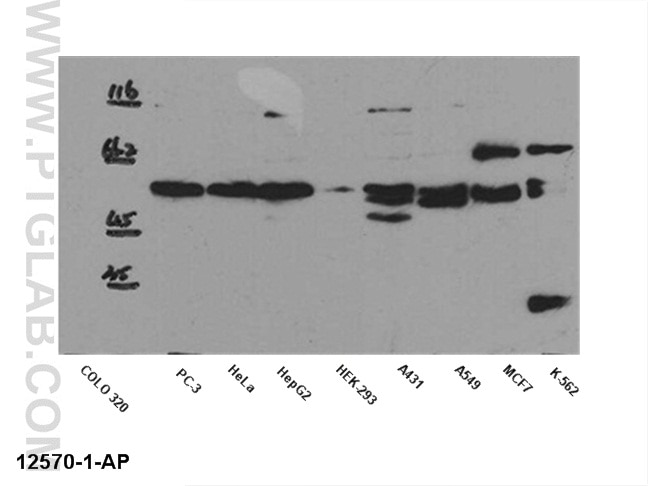- Featured Product
- KD/KO Validated
WWTR1 Polyklonaler Antikörper
WWTR1 Polyklonal Antikörper für IF, IP, WB, ELISA
Wirt / Isotyp
Kaninchen / IgG
Getestete Reaktivität
human, Ratte und mehr (1)
Anwendung
WB, IP, IHC, IF, CoIP, ChIP, ELISA
Konjugation
Unkonjugiert
Kat-Nr. : 23306-1-AP
Synonyme
Galerie der Validierungsdaten
Geprüfte Anwendungen
| Erfolgreiche Detektion in WB | HeLa-Zellen, LN229-Zellen, MDA-MB-453s-Zellen |
| Erfolgreiche IP | MDA-MB-453s-Zellen |
| Erfolgreiche Detektion in IF | Rattennierengewebe |
Empfohlene Verdünnung
| Anwendung | Verdünnung |
|---|---|
| Western Blot (WB) | WB : 1:1000-1:8000 |
| Immunpräzipitation (IP) | IP : 0.5-4.0 ug for 1.0-3.0 mg of total protein lysate |
| Immunfluoreszenz (IF) | IF : 1:50-1:500 |
| It is recommended that this reagent should be titrated in each testing system to obtain optimal results. | |
| Sample-dependent, check data in validation data gallery | |
Veröffentlichte Anwendungen
| KD/KO | See 6 publications below |
| WB | See 37 publications below |
| IHC | See 11 publications below |
| IF | See 6 publications below |
| IP | See 3 publications below |
| CoIP | See 1 publications below |
| ChIP | See 1 publications below |
Produktinformation
23306-1-AP bindet in WB, IP, IHC, IF, CoIP, ChIP, ELISA WWTR1 und zeigt Reaktivität mit human, Ratten
| Getestete Reaktivität | human, Ratte |
| In Publikationen genannte Reaktivität | human, Maus, Ratte |
| Wirt / Isotyp | Kaninchen / IgG |
| Klonalität | Polyklonal |
| Typ | Antikörper |
| Immunogen | WWTR1 fusion protein Ag19659 |
| Vollständiger Name | WW domain containing transcription regulator 1 |
| Berechnetes Molekulargewicht | 44 kDa |
| Beobachtetes Molekulargewicht | 50 kDa |
| GenBank-Zugangsnummer | BC014052 |
| Gene symbol | WWTR1 |
| Gene ID (NCBI) | 25937 |
| Konjugation | Unkonjugiert |
| Form | Liquid |
| Reinigungsmethode | Antigen-Affinitätsreinigung |
| Lagerungspuffer | PBS mit 0.02% Natriumazid und 50% Glycerin pH 7.3. |
| Lagerungsbedingungen | Bei -20°C lagern. Nach dem Versand ein Jahr lang stabil Aliquotieren ist bei -20oC Lagerung nicht notwendig. 20ul Größen enthalten 0,1% BSA. |
Hintergrundinformationen
TAZ, also referred as WWTR1, is a transcriptional co-activator with a PDZ-binding motif that is regulated by its interaction with 14-3-3 protein. TAZ is expressed in many primary tumors, such as breast cancer, thyroid carcinoma, colorectal cancer, and glioma. TAZ has been reported to be one of the nuclear effectors of Hippo-related pathways that regulate organ size control, cancer stem cell (CSC) properties, and epithelial-mesenchymal transition (EMT). TAZ has been defined for its role in the nucleus, where it functions directly as a transcriptional regulator by interacting with several nuclear factors as Runx2/Cbfa1, NHERF-2, TEF-1, TBX5, PAX3, PAX8 and TTF-1.
Protokolle
| Produktspezifische Protokolle | |
|---|---|
| WB protocol for WWTR1 antibody 23306-1-AP | Protokoll herunterladen |
| IF protocol for WWTR1 antibody 23306-1-AP | Protokoll herunterladen |
| IP protocol for WWTR1 antibody 23306-1-AP | Protokoll herunterladen |
| Standard-Protokolle | |
|---|---|
| Klicken Sie hier, um unsere Standardprotokolle anzuzeigen |
Publikationen
| Species | Application | Title |
|---|---|---|
Cancer Cell Programming of Schwann Cells by Lats1/2-TAZ/YAP Signaling Drives Malignant Peripheral Nerve Sheath Tumorigenesis. | ||
Nat Neurosci YAP and TAZ control peripheral myelination and the expression of laminin receptors in Schwann cells.
| ||
Sci Adv YAP drives fate conversion and chemoresistance of small cell lung cancer.
| ||
Bone Res TAZ inhibits osteoclastogenesis by attenuating TAK1/NF-κB signaling.
| ||
J Hazard Mater The proteasome-dependent degradation of ALKBH5 regulates ECM deposition in PM2.5 exposure-induced pulmonary fibrosis of mice. |
Rezensionen
The reviews below have been submitted by verified Proteintech customers who received an incentive forproviding their feedback.
FH Yohanes (Verified Customer) (04-24-2023) |
|
FH Joshua (Verified Customer) (02-28-2020) | MDCKs fixed in 4% paraformaldehyde. Bright Mix of nuclear and cytosolic staining
 |

